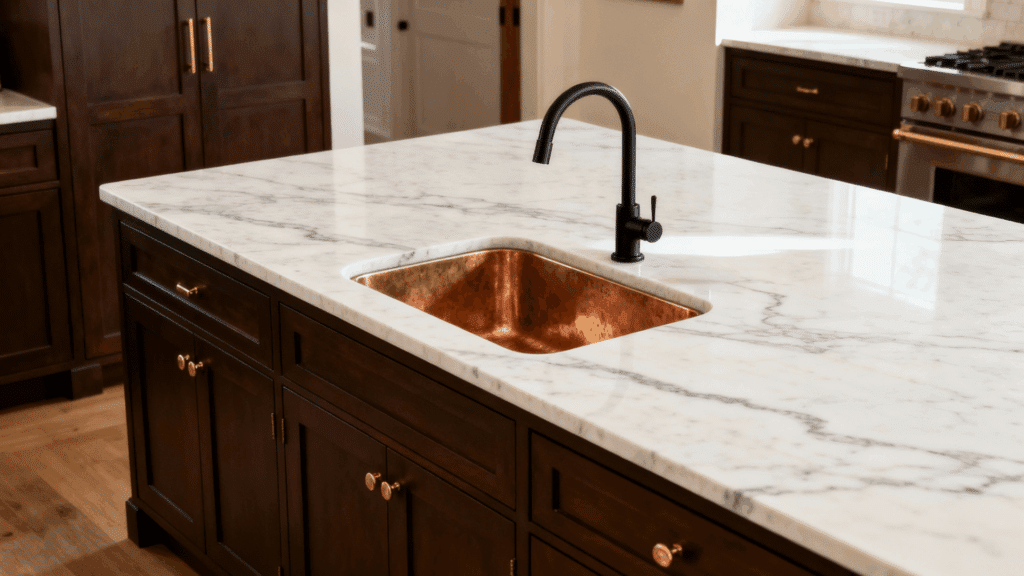Choosing the right countertop can feel amazing, given the many options today. Your kitchen counters see daily use from meal prep to homework, so picking the best material for countertops matters more than you think.
The perfect surface needs to handle spills, heat, scratches, and constant activity while looking great for years.
Some materials cost less upfront but require more maintenance, while others demand higher investment but last for decades with minimal care.
Understanding what each material offers helps you make a smart decision that fits your lifestyle and budget.
Key Factors to Consider Before Choosing Material for Kitchen Countertops
Selecting the right countertop material requires careful evaluation of your lifestyle and long-term maintenance expectations.
- Budget Range: Determine how much you can realistically spend on materials and installation combined before falling for expensive options.
- Maintenance Requirements: Consider how much time and effort you want to spend on cleaning, sealing, and protecting your countertops regularly.
- Durability Needs: Think about your cooking habits and whether you need surfaces that resist heat, scratches, stains, and heavy daily use.
- Visual Preferences: Choose colors, patterns, and textures that match your kitchen style and complement your existing cabinets and flooring.
- Resale Value: Research which materials homebuyers prefer in your area if you plan to sell your house within the next few years.
- Installation Timeline: Understand that some materials require weeks of fabrication, while others can be installed quickly after ordering.
Best Material for Kitchen Countertops
Choosing the right countertop material enhances your kitchen’s functionality and style while fitting your budget and lifestyle.
1. Granite Countertops
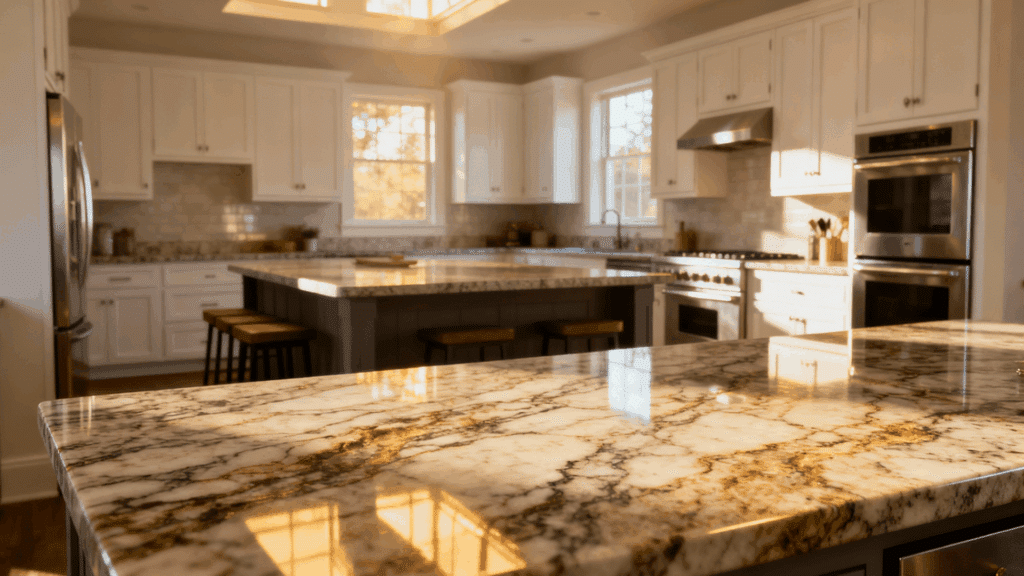
Granite remains one of the most popular natural stone choices for kitchens across the country.
This material forms deep underground from cooled magma, creating unique patterns that make each slab completely one-of-a-kind.
The natural variations in color and veining mean no two granite countertops ever look exactly alike.
| Pros | Cons |
|---|---|
| Heat-resistant surface handles hot pots without damage. | Requires regular sealing to prevent staining. |
| Each slab offers unique natural patterns and colors. | Professional installation is required due to the unit’s weight. |
| Increases home value and appeals to buyers. | Seams are visible in larger kitchen layouts. |
| The mid to high price range fits many budgets. | It can crack or chip if heavy objects drop on the edges. |
2. Quartz Countertops

Quartz countertops combine natural quartz crystals with resins to create engineered stone surfaces.
Manufacturers crush quartz minerals and bind them with polymers, resulting in incredibly durable slabs.
The non-porous surface never needs sealing because bacterial growth naturally occurs. These work well for families who want beauty without maintenance.
| Pros | Cons |
|---|---|
| Non-porous surface never requires sealing maintenance. | Cannot withstand direct heat from pots and pans. |
| Consistent colors and patterns throughout the entire slab. | Higher price point than many natural stones. |
| Resists stains, scratches, and bacterial growth effectively. | Cannot be used outdoors due to UV sensitivity. |
| Best for low-maintenance households wanting durability. | Visible seams in some installations, depending on layout. |
3. Marble Countertops
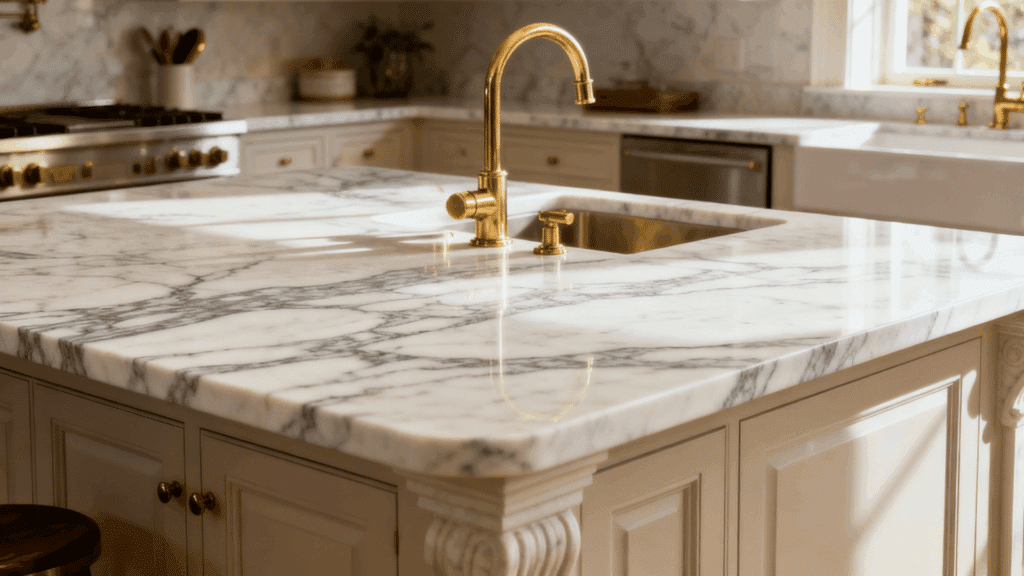
Marble brings lasting beauty and luxury to kitchen spaces with its distinctive veining patterns on the countertops.
This metamorphic rock forms when limestone undergoes intense heat and pressure deep within the Earth.
The soft, cool surface feels pleasant to touch and works exceptionally well for pastry making and candy preparation.
| Pros | Cons |
|---|---|
| Luxurious appearance of any kitchen design style. | Highly porous and stains easily from acids and oils. |
| Cool surface temperature is ideal for baking and pastries. | Scratches and etches more easily than harder stones. |
| Lasting style that never goes out of style. | Expensive material and installation costs add up quickly. |
| Best for formal kitchens with careful owners. | Requires frequent sealing and special cleaning products. |
4. Butcher Block Countertops

Butcher block countertops consist of wood strips glued together to create a thick, sturdy work surface.
Common wood choices include maple, oak, cherry, and walnut, each offering different grain patterns and colors.
These surfaces can be sanded down and refinished multiple times over their lifespan, essentially renewing them completely.
| Pros | Cons |
|---|---|
| Warm, natural appearance creates an inviting kitchen atmosphere. | Requires regular oiling to prevent drying and cracking. |
| It can be sanded and refinished to remove damage. | Water damage and staining occur without proper maintenance. |
| Gentle on knives and provides a built-in cutting surface. | Burns easily from hot pans placed directly on wood. |
| Moderate pricing makes it accessible for many budgets. | Best for dedicated owners willing to maintain regularly. |
5. Laminate Countertops
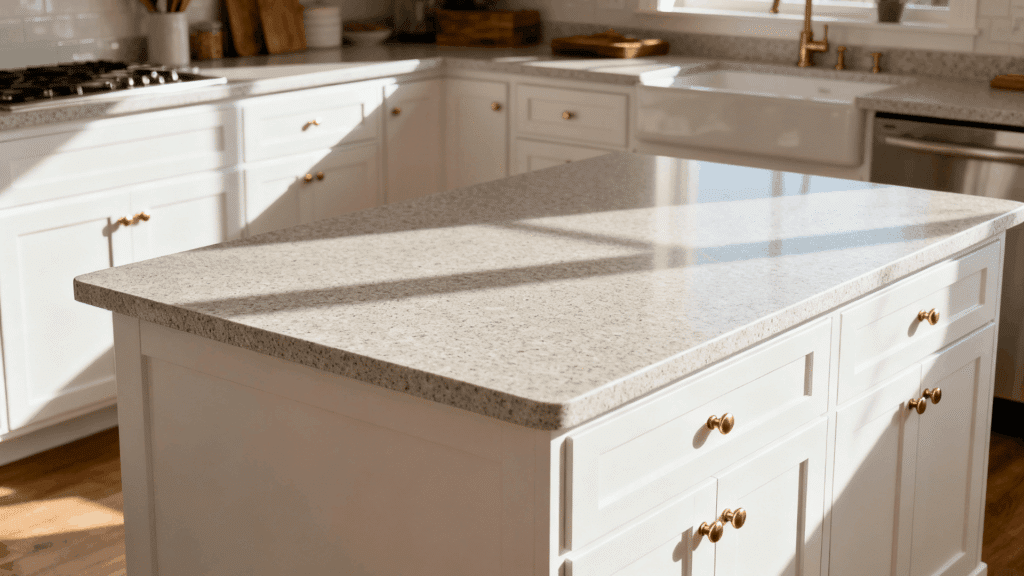
Laminate consists of a plastic coating bonded to a particleboard or plywood substrate underneath.
Modern laminate technology creates convincing replicas of stone, wood, and concrete at a fraction of the cost.
The thin plastic layer comes in countless colors, patterns, and finishes to suit any kitchen style preference.
| Pros | Cons |
|---|---|
| Most affordable countertop option available on the market. | Cannot be repaired if damaged or burned. |
| Easy installation is often completed in a single day. | Lower resale value compared to stone materials. |
| A huge variety of colors and patterns to choose from. | Visible seams at joints where sections meet. |
| Best for rental properties and tight budgets. | Heat damage occurs from hot pots placed directly on the surface. |
6. Concrete Countertops
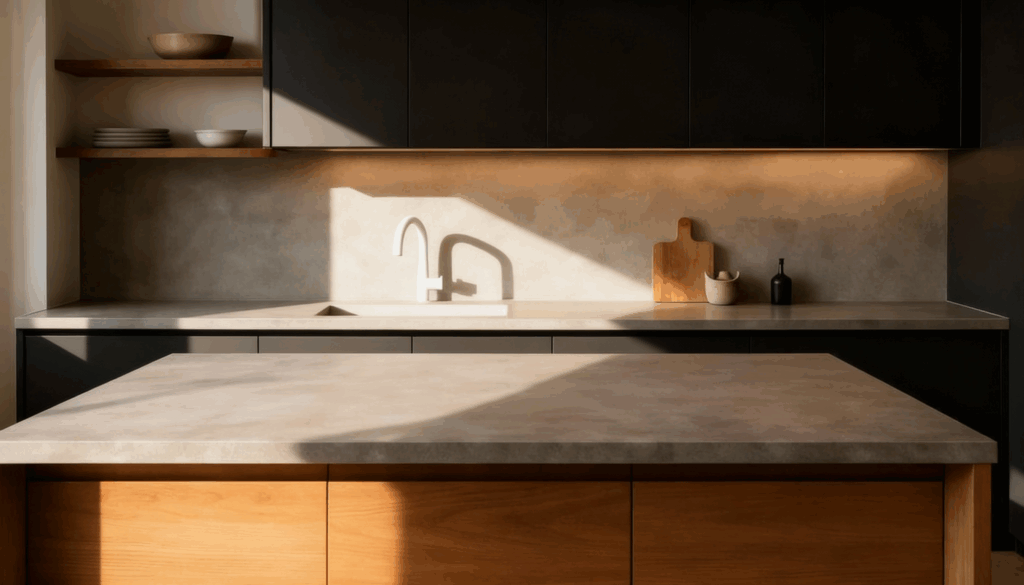
Concrete countertops offer complete customization for unique kitchen designs. Contractors pour concrete into custom molds, creating any shape, size desired.
Pigments added during mixing create custom colors that perfectly match your vision. The surface can be left smooth, textured, or embedded with glass, etc.
Concrete develops a natural patina over time that some homeowners love, while others prefer to maintain a pristine appearance.
| Pros | Cons |
|---|---|
| Completely customizable in shape, color, and thickness. | Heavy-weight requires reinforced cabinet support structures. |
| Heat-resistant surface handles hot cookware safely. | It can crack over time from settling or impact. |
| Unique industrial style suits modern kitchen designs. | Requires regular sealing to prevent stains and damage. |
| Mid to high price depending on customization level. | Best for homeowners wanting truly custom, artistic surfaces. |
7. Soapstone Countertops

Soapstone is a natural metamorphic rock composed of minerals, giving it a soft feel. The material typically comes in shades of gray, ranging from light silver.
Unlike granite, soapstone is naturally non-porous and never requires sealing to protect against stains.
The stone darkens over time as natural oils in the stone oxidize, creating a rich patina. Many homeowners speed this process by applying mineral oil regularly.
| Pros | Cons |
|---|---|
| Non-porous surface never needs sealing treatments. | Limited color options, mostly gray tones available. |
| Heat-resistant and won’t burn from hot pans. | Scratches and dents more easily than harder stones. |
| Natural darkening creates a beautiful aged appearance over time. | Higher cost compared to granite or quartz. |
| Best for rustic or traditional kitchen design styles. | Scratches are visible but can be sanded smooth again. |
8. Tile Countertops
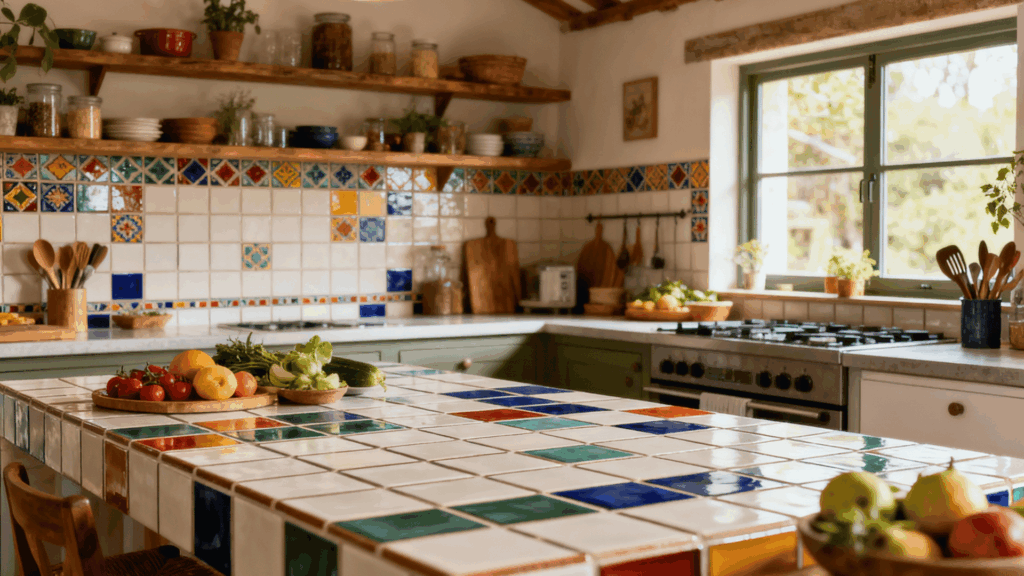
Tile countertops use ceramic or porcelain tiles set in mortar and sealed with grout. Individual tiles can be replaced if damaged without replacing the surface.
The modular nature allows for creative patterns, borders, and custom designs using different colors.
Tile works particularly well for curved or irregular counter shapes that challenge solid materials.
| Pros | Cons |
|---|---|
| Individual tiles can be replaced if cracked or damaged. | Grout lines stain easily and require regular maintenance. |
| Budget-friendly option with DIY installation possible. | An uneven surface makes rolling dough difficult. |
| Heat-resistant ceramic handles hot pots safely. | Glasses and dishes break more easily on a hard surface. |
| Best for small budgets and creative custom designs. | Grout joints collect dirt and bacteria without proper sealing. |
9. Stainless Steel Countertops
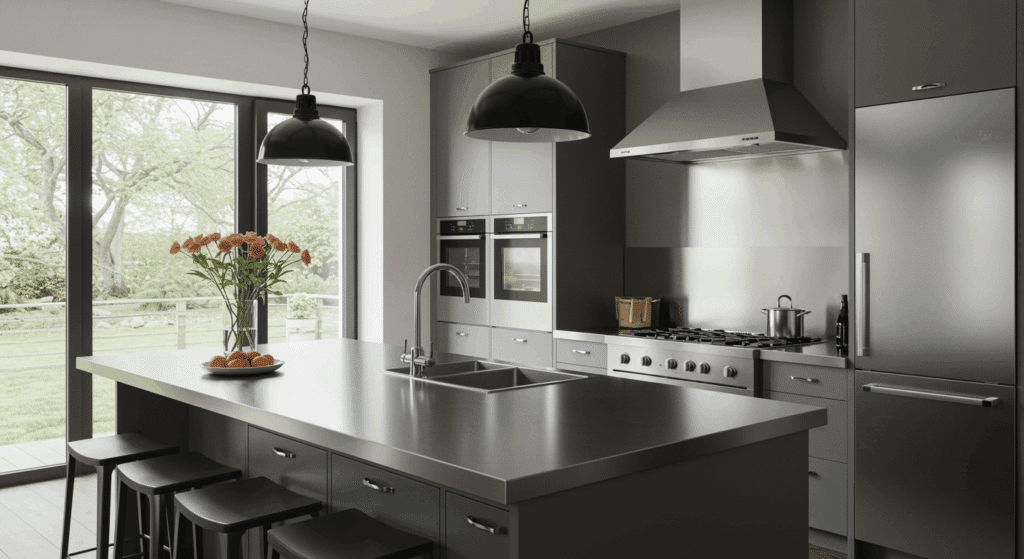
Stainless steel countertops bring a professional kitchen style into residential spaces. The non-porous metal surface resists bacteria, stains, and heat naturally.
Commercial kitchens favor this material for its sanitary and incredible durability. The reflective surface brightens kitchens by bouncing light around the space effectively.
Modern residential versions come with various finishes from mirror-polished to brushed textures.
| Pros | Cons |
|---|---|
| Non-porous and naturally antibacterial for food safety. | Shows fingerprints, smudges, and water spots easily. |
| Heat-resistant and won’t burn or scorch in pots. | Scratches and dents are visible on the smooth surface. |
| Modern industrial look suits contemporary kitchen designs. | Expensive compared to laminate or tile options. |
| Best for serious cooks wanting a professional kitchen feel. | Noisy when placing dishes and cookware on the surface. |
10. Recycled Glass Countertops
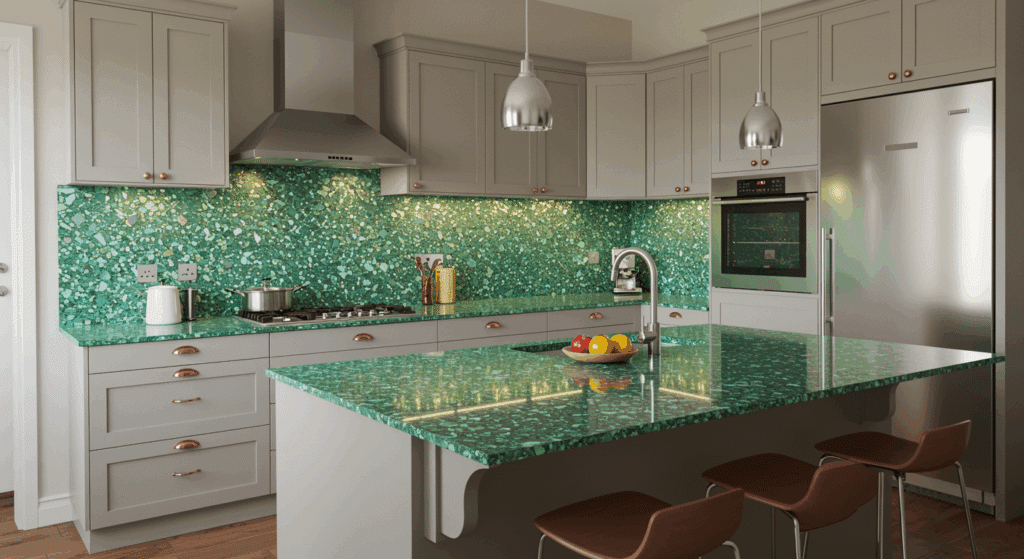
Recycled glass countertops combine crushed glass pieces with cement or resin binders. The glass fragments create a sparkling effect that makes bold statements.
Manufacturers use recycled bottles and other glass waste, making this an environmentally conscious choice.
The glass pieces can be large and chunky or finely ground, depending on the desired appearance.
| Pros | Cons |
|---|---|
| Environmentally friendly, using recycled glass materials. | Higher price point due to specialized manufacturing. |
| Unique, eye-catching appearance with sparkling glass pieces. | Can chip at edges if subjected to hard impacts. |
| Heat-resistant and durable for daily kitchen use. | Limited availability compared to mainstream materials. |
| Best for eco-conscious homeowners wanting statement pieces. | Requires sealing if cement-based rather than resin-bound. |
11. Solid Surface Countertops

Solid surface materials like Corian consist of acrylic or polyester resins mixed with mineral fillers.
The material is manufactured in sheets or molded into seamless custom shapes. Color runs the entire thickness, so scratches and damage can be sanded away.
The non-porous surface resists stains and never needs sealing like natural stone requires. Seams can be fused invisibly, creating one continuous surface.
| Pros | Cons |
|---|---|
| A repairable surface can be sanded to remove scratches. | Not as heat-resistant as stone materials. |
| Seamless appearance with invisible joints is possible. | Can scorch or melt from very hot pans. |
| Non-porous and resistant to stains and bacteria. | Shows wear over time in high-traffic areas. |
| Best for families wanting low-maintenance, repairable surfaces. | Mid-range pricing between laminate and natural stone. |
12. Quartzite Countertops

Quartzite is a natural stone formed when sandstone undergoes metamorphosis through heat and pressure.
This is one of the hardest natural stones available for countertops. The material often features beautiful veining similar to marble but with superior durability.
Quartzite resists scratching, etching, and heat better than most natural stones. Colors range from soft whites and grays to dramatic golds and blues.
| Pros | Cons |
|---|---|
| Extremely hard and durable, it resists scratches exceptionally. | Expensive material with high fabrication and installation costs. |
| Heat-resistant and can handle hot cookware safely. | Requires periodic sealing to maintain stain resistance. |
| Beautiful natural patterns rival marble’s appearance. | Limited color selection compared to engineered options. |
| Best for luxury kitchens wanting durability with beauty. | Heavy material requires professional installation and strong cabinets. |
13. Limestone Countertops
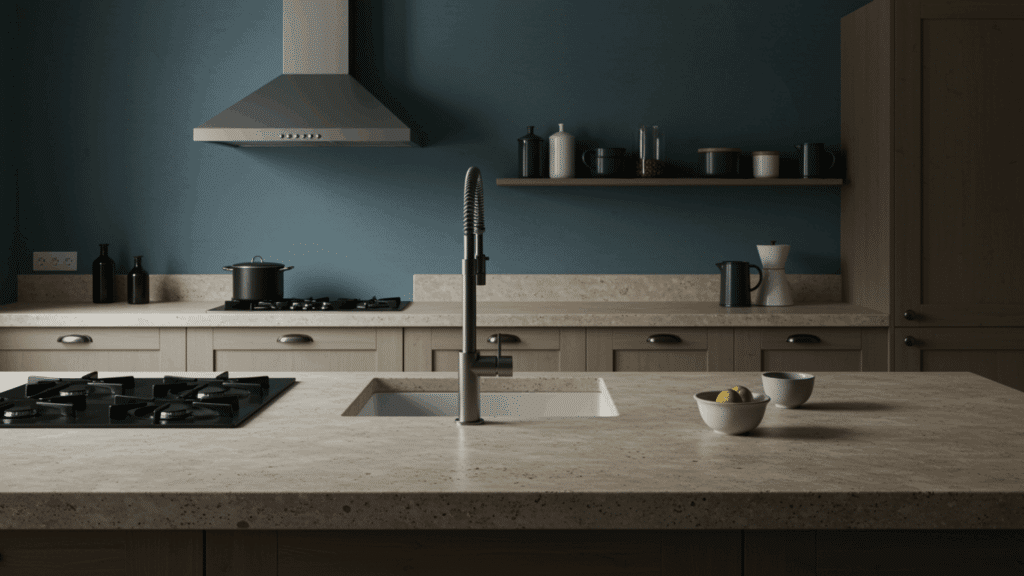
Limestone is a sedimentary rock formed from compressed shells and organic material over millions of years.
This natural stone offers a softer, more matte appearance compared to polished granite or marble.
The material typically comes in neutral earth tones like beige, cream, tan, and gray that create calming kitchen atmospheres.
| Pros | Cons |
|---|---|
| Soft, matte finish creates warm, natural style appeal. | Very porous and stains easily from liquids and acids. |
| Neutral earth tones complement traditional and rustic designs. | Softer surface scratches and etches more than harder stones. |
| Moderate pricing compared to marble or exotic stones. | Requires frequent sealing every few months for protection. |
| Best for light-use kitchens or bar areas with minimal food prep. | Not suitable for busy households with heavy cooking activity. |
14. Porcelain Slab Countertops

Porcelain slab countertops represent newer technology that creates large-format surfaces through extreme heat and pressure.
Unlike ceramic tiles, these slabs come in sizes similar to natural stone. This process allows for realistic recreations of marble and other materials.
The non-porous surface never needs sealing and maintains its appearance with minimal effort.
| Pros | Cons |
|---|---|
| Extremely durable and resistant to scratches and stains. | It can chip or crack at the edges if impacted hard. |
| Non-porous surface never requires sealing or special treatments. | Higher cost than laminate, with limited fabricator availability. |
| Lightweight material is easier to install than heavy stone. | Seems more visible than some natural stone options. |
| Best for modern kitchens wanting low-maintenance durability. | Relatively new product with less long-term performance data. |
15. Travertine Countertops

Travertine forms near mineral springs where calcium carbonate deposits create layered sedimentary rock.
The stone features a distinctive pitted surface texture with natural holes and voids throughout.
These characteristic holes can be filled during fabrication for smoother surfaces or left open for rustic beauty.
| Pros | Cons |
|---|---|
| Unique textured appearance with natural pits adds character. | Porous stone absorbs stains quickly without proper sealing. |
| Warm earth tones create an inviting, comfortable kitchen atmosphere. | Natural holes and pits can trap food particles and debris. |
| Less expensive than marble while offering a similar style. | Scratches and etches easily from acidic foods and cleaners. |
| Best for Mediterranean or rustic kitchen design styles. | Requires regular sealing and careful maintenance to preserve. |
16. Bamboo Countertops
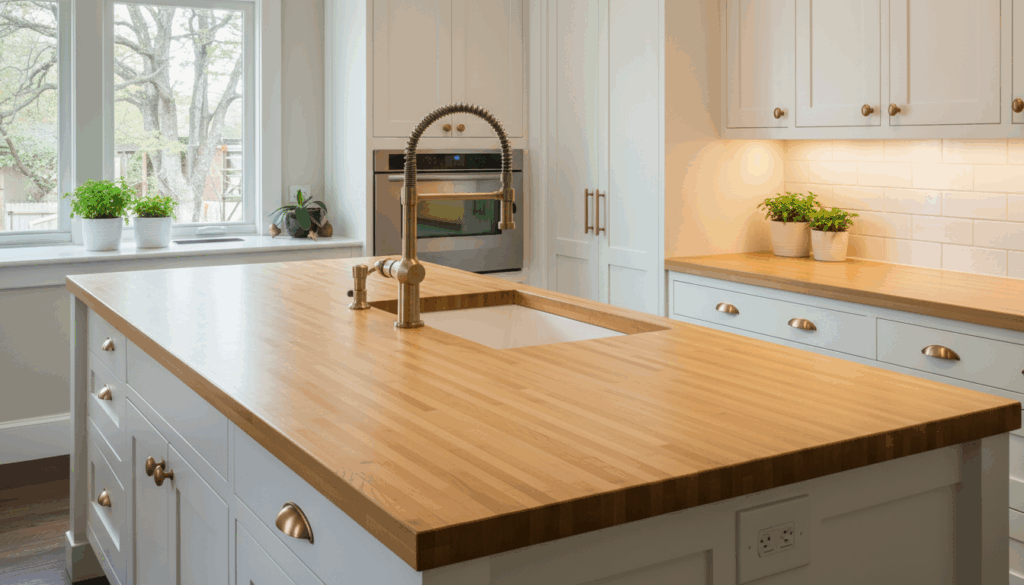
Bamboo countertops offer an eco-friendly alternative to traditional hardwood butcher block surfaces.
Bamboo grass grows rapidly, reaching maturity in just three to five years compared to decades for hardwood trees.
The material comes in natural blonde tones achieved through heating. Bamboo is harder than many woods, offering better resistance to dents and scratches.
| Pros | Cons |
|---|---|
| A rapidly renewable resource makes it an environmentally sustainable choice. | Requires regular oiling and maintenance like wood surfaces. |
| Harder and more durable than many traditional wood options. | Water damage occurs if spills are not wiped promptly. |
| Unique grain patterns create a distinctive, modern organic look. | It can warp or swell in humid conditions without proper care. |
| Best for eco-conscious homeowners wanting sustainable materials. | Moderate pricing similar to quality hardwood butcher block. |
17. Copper Countertops

Copper countertops bring warm metallic beauty and antimicrobial properties to kitchen spaces. The living metal develops a natural patina over time.
Changing from bright penny color to rich browns. Some homeowners love this aging process, while others prefer to maintain the original shine.
Copper naturally kills bacteria on contact, making it one of the most sanitary countertop choices available.
| Pros | Cons |
|---|---|
| Natural antimicrobial properties kill bacteria without chemicals. | Expensive material with high fabrication costs. |
| Develops unique patina over time, creating a one-of-a-kind appearance. | Dents and scratches easily from normal kitchen use. |
| Warm metallic tones add richness to kitchen design. | Requires regular polishing to maintain a bright finish. |
| Best for artistic homeowners wanting distinctive living surfaces. | Limited availability and few fabricators with experience in copper. |
Tips for Choosing the Right Countertop Material
Selecting the perfect countertop material upgrades your kitchen style while fitting your budget and lifestyle needs perfectly.
- Lifestyle Match: Choose materials that align with your cooking frequency, family size, and willingness to perform regular maintenance tasks consistently.
- Test Samples: Request material samples to view in your actual kitchen lighting and against your cabinets before making final selections.
- Future Plans: Consider how long you plan to stay in your home and whether the investment makes sense for your timeline.
- Professional Consultation: Meet with kitchen designers or contractors who can explain what works best for your specific layout and usage patterns.
- Warranty Coverage: Compare manufacturer warranties and understand what damage or wear they cover over the material’s expected lifespan.
- Installation Requirements: Research whether your chosen material needs structural reinforcement or extended fabrication time before installation begins.
Conclusion
Selecting the best material for countertops depends on balancing your budget, maintenance preferences, and design goals thoughtfully.
Each material offers distinct advantages and challenges that suit different households and cooking styles.
The right choice for your neighbor might not be the best material for kitchen countertops in your home. Consider how you actually use your kitchen daily.
Ready to upgrade your kitchen with perfect countertops? Measure your space, and start comparing samples to find the surface that will serve your family beautifully.

